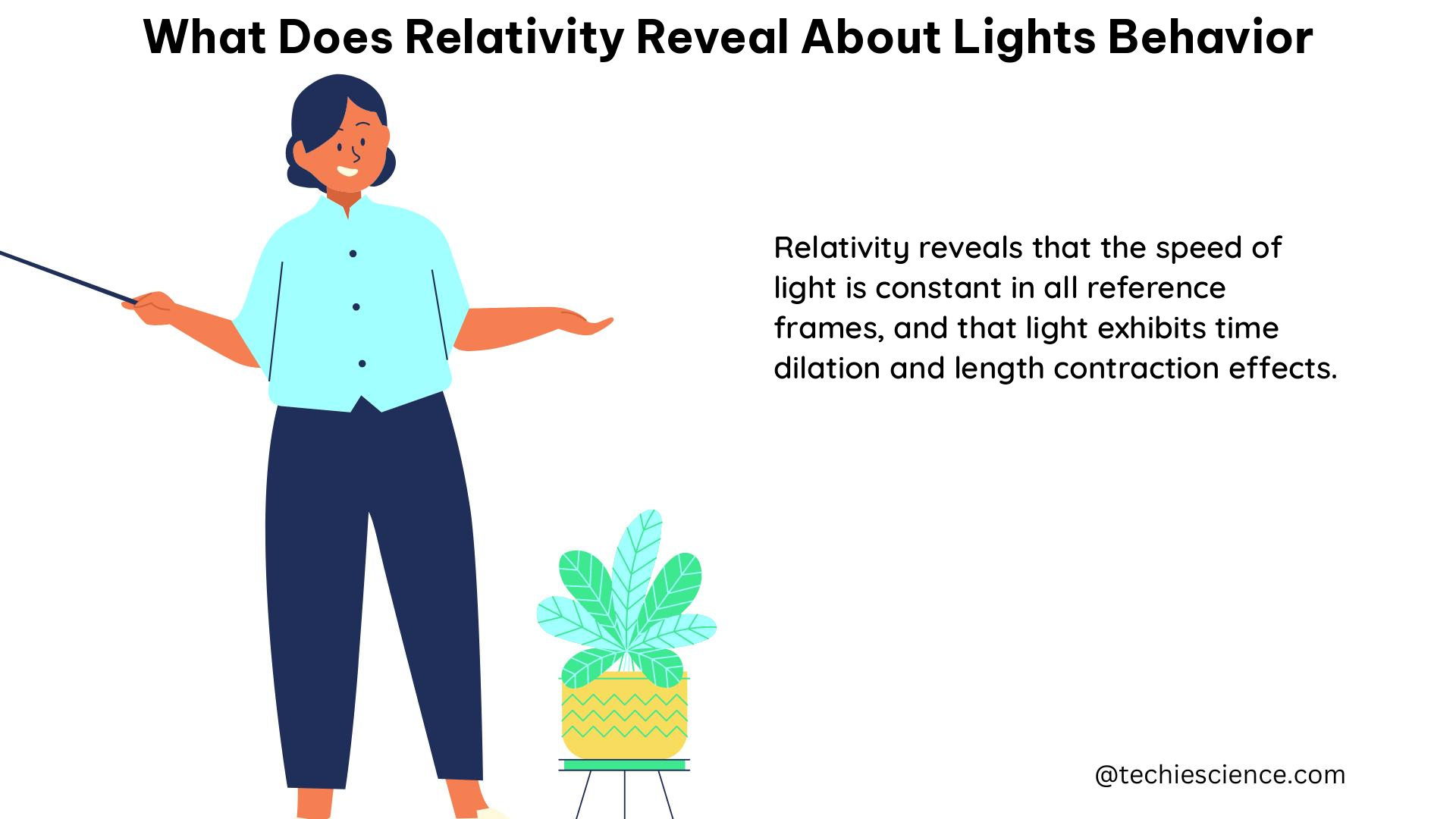Relativity, both special and general, provides a comprehensive framework for understanding the fundamental properties and behavior of light. From the invariant speed of light to its intricate interactions with massive objects, relativity offers a wealth of insights that have been extensively tested and validated through rigorous experiments and observations.
Invariant Speed of Light
According to the principles of special relativity, the speed of light in a vacuum, denoted as c, is a universal constant, independent of the motion of the observer or the source of light. This is mathematically represented as:
c = 299,792,458 m/s
The invariance of the speed of light is a cornerstone of special relativity and has been tested to an extraordinary degree of precision. Modern experiments have placed bounds on deviations from the speed of light at the level of 1 part in 10^9, or approximately 0.0000000001%.
One of the most famous experiments that demonstrated the invariance of the speed of light was the Michelson-Morley experiment, conducted in 1887. This experiment aimed to detect the existence of the “luminiferous ether,” a hypothetical medium that was thought to permeate all of space and serve as the medium for the propagation of light. The Michelson-Morley experiment, however, failed to detect any evidence of the ether, providing strong support for the idea that the speed of light is indeed a universal constant.
Light Deflection and Gravitational Lensing

General relativity, developed by Albert Einstein, predicts that light will be deflected as it passes near a massive object, such as a star or a planet. This phenomenon, known as gravitational lensing, has been observed and measured extensively, providing strong experimental support for the theory of general relativity.
The amount of light deflection is determined by the strength of the gravitational field and the distance of the light path from the massive object. The mathematical expression for the deflection angle, α, is given by:
α = 4GM/c^2r
Where:
– G is the gravitational constant
– M is the mass of the massive object
– c is the speed of light
– r is the distance of closest approach of the light path to the massive object
The deflection of light by the Sun has been measured with high precision, with the Cassini probe achieving an accuracy of 0.002% in its measurements. On a larger scale, the gravitational lensing of light by elliptical galaxies has been used to place a 10% bound on the parameter γ, which is a measure of the strength of gravity in general relativity.
Time Delay and Shapiro Delay
General relativity also predicts a time delay in the round-trip travel time for radar signals reflecting off other planets, known as the Shapiro delay. This delay becomes progressively larger when the photon passes nearer to the Sun due to the time dilation in the gravitational potential of the Sun.
The Shapiro delay can be expressed mathematically as:
Δt = (2G/c^3) * ln(r_2/r_1)
Where:
– Δt is the time delay
– G is the gravitational constant
– c is the speed of light
– r_1 and r_2 are the distances of the photon from the Sun at the beginning and end of the round-trip, respectively.
Observations of radar reflections from Mercury and Venus just before and after they are eclipsed by the Sun have been found to agree with the general relativity theory of the Shapiro delay at the 5% level.
Lorentz Invariance and Challenges to Special Relativity
Special relativity, with its cornerstone principle of Lorentz invariance, has been extensively tested and validated in numerous experiments. Lorentz invariance states that the laws of physics are the same in all inertial reference frames, and this has been confirmed to an extraordinary degree of precision.
However, recent theoretical and experimental efforts have been launched to search for potential violations of Lorentz invariance, particularly in the context of quantum gravity models. These models suggest the possibility of “effective” violations of Lorentz invariance, which could manifest as small deviations from the expected behavior of light.
Experiments have placed stringent bounds on deviations from Lorentz invariance, with the best limits reaching the level of 1 part in 10^17. These results provide strong support for the validity of special relativity and the Lorentz invariance of the laws of physics.
Conclusion
Relativity, both special and general, has revealed a wealth of insights about the fundamental properties and behavior of light. From the invariant speed of light to its intricate interactions with massive objects, the predictions of relativity have been extensively tested and validated through a wide range of experiments and observations.
The invariance of the speed of light, the deflection of light by gravity, the Shapiro delay, and the Lorentz invariance of the laws of physics are all key aspects of relativity that have been confirmed with remarkable precision. These findings have not only provided strong support for the theories of special and general relativity but have also deepened our understanding of the nature of light and the underlying principles that govern the universe.
As our scientific understanding continues to evolve, the insights provided by relativity remain at the forefront of physics, guiding our exploration of the cosmos and shaping our fundamental understanding of the universe.
References:
1. Do we know why there is a speed limit in our universe?
2. My Do-It-Yourself Relativity Test
3. Tests of general relativity
4. Tests of general relativity

The lambdageeks.com Core SME Team is a group of experienced subject matter experts from diverse scientific and technical fields including Physics, Chemistry, Technology,Electronics & Electrical Engineering, Automotive, Mechanical Engineering. Our team collaborates to create high-quality, well-researched articles on a wide range of science and technology topics for the lambdageeks.com website.
All Our Senior SME are having more than 7 Years of experience in the respective fields . They are either Working Industry Professionals or assocaited With different Universities. Refer Our Authors Page to get to know About our Core SMEs.